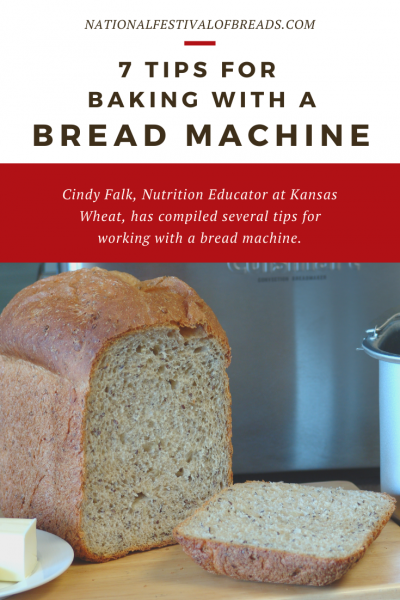By Cindy Falk, Nutrition Educator at Kansas Wheat
The bread machine can be one of the greatest kitchen tools for providing homemade healthy whole grain products for a home and family. Cindy Falk, Nutrition Educator at Kansas Wheat, has compiled several tips for working with a bread machine. Intended for both the experienced bread machine baker and the beginner these tips are ones to remember.

1. Bread flour is preferred for use in bread machines. Finished products will have greater volume and a finer texture. Bread flour is a blend of hard, high protein wheats, and has greater gluten strength.
2. Accurately measure all ingredients. Measure precisely using appropriate measuring tools. An incorrect measurement of liquid or flour can make a big difference. Measure liquids in a clear liquid measuring cup at eye level, dry ingredients using dry measuring tools, and for how to correctly measure flour check out this post.
3. Don’t be afraid to open the lid. It’s perfectly alright to open the machine and touch the dough to check its consistency. Do this about 5 minutes into the dough cycle. The dough should be a soft, smooth, ball around the kneading blade. If the dough is too dry add liquid 1 teaspoon at a time. If the dough is too wet, add 1 teaspoon of flour at a time until the appropriate consistency is reached.
4. Check ingredients for freshness especially the yeast! If the yeast has passed the expiration date, you will end up with a brick. Always be sure to use the type of yeast recommended by the recipe for best results.
5. Liquids should be at room temperature. 70˚-80˚F is the best temperature for liquid ingredients. Measure liquids with a thermometer for consistent results.
6. Keep yeast away from salt, fats, liquids, and wet ingredients. Never add salt in direct contact with yeast because salt will inhibit the growth of yeast. If using a delay timer, make sure the yeast is on top of bread flour, away from the liquids.
7. Never use perishable items with the delay cycle (fresh milk, meats, eggs, cheese, fresh fruits and vegetables). They may spoil, possibly causing a food-borne illness and no one wants that!
Different climates and seasons result in a variety of humidity levels and you may need to adjust the liquid or flour amounts accordingly.
Have questions about baking, using your bread machine, or more? Comment below or head over to our Ask a Question section to get help from Cindy in your kitchen!




No comments yet.